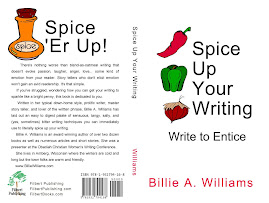
Accessibility, Don’t Handicap Yourself
By Billie A Williams © 2007
So how do you make the printed words of your story accessible or meaningful to the reader? Always get your story down to the levels of individuals. Individuals are people we can see and identify with. If you make reference to the Senior Citizen population you get a ho hum, yeah we’ve heard of them, from your audience. But if you say Marge Peterman who lives next door – we see her, to name someone is to personalize them.
It’s hard to see the individual trees when faced with a dense forest. Single out a stately Elm or a beautiful Weeping Willow and our minds will conger up our picture of them. It becomes a certain type of tree, which we recognize. A forest can be many things to many different people. A red wood forest, a pine forest, a forest of red maples, a mixed woodland forest will all bring a different picture to your reader— be specific, more specific than a forest. Specificity makes the reader see YOUR picture.
Another way to make your story meaningful to your reader is to print word pictures that set the tone very early on. Tone reflects the attitude of the protagonist toward his situation and puts the reader in a frame of mind to accept his response to that situation. It’s more than weather, it’s atmosphere, total environment.
Speaking of weather, there is much discussion about whether or not to open your story with weather. At best it’s a chancy situation. If your character is not invested someway in the weather situation , if he isn’t experiencing it in some way tied to his emotional, physical and or psychological well-being, you will be stopping your story to look at the stars or some thing similar and your reader will slip free from your story thread.
Nature, the environment, can evoke a feeling of foreboding. Remember tone is the way to make the weather matter, to elicit the feeling you want your reader to feel. The mood you want to create will benefit from the tone, when used properly. You don’t need a panoramic view of a sunny day, or a cloudless sky, but weather and environment for a reason like Patricia Cornwell does in Black Notice. “The late morning blazed with blue skies and colors of fall, but none of it was for me.”
You need to make sure weather isn’t just a side trip, an author intrusion, an engine idling before the story takes off. It must be connected to, or with, your main character, and with your plot. Otherwise, it becomes extra baggage and unnecessary background like back story. Unless it distinctly helps to set mood or tone, it is merely fluff—unnecessary and distracting. You can do better.
“…take a hint from the developers of real estate and don’t let your grand opening depend on the weather,” Chris Roerden in Don’t Murder Your Mystery.
Choose your opening carefully. It’s your only chance to snag your reader and reel him into your story world. Keep in mind…”Fiction does not exist on paper. It exists within the mind of the reader. Use just enough words to get the mind working,” J.A. Konrath.
Add just enough tensile strength to pull you reader along and into the story, not letting them tug free, but continue pulling them deep, deeper into your story without spitting out your hook, or breaking your story line and moving on to the next book on the shelf. Make your story accessible to your reader. That is, help them get into the story quickly and stay there.
Billie A Williams
www.billiewilliams.com
www.pensinmotion.com











No comments:
Post a Comment